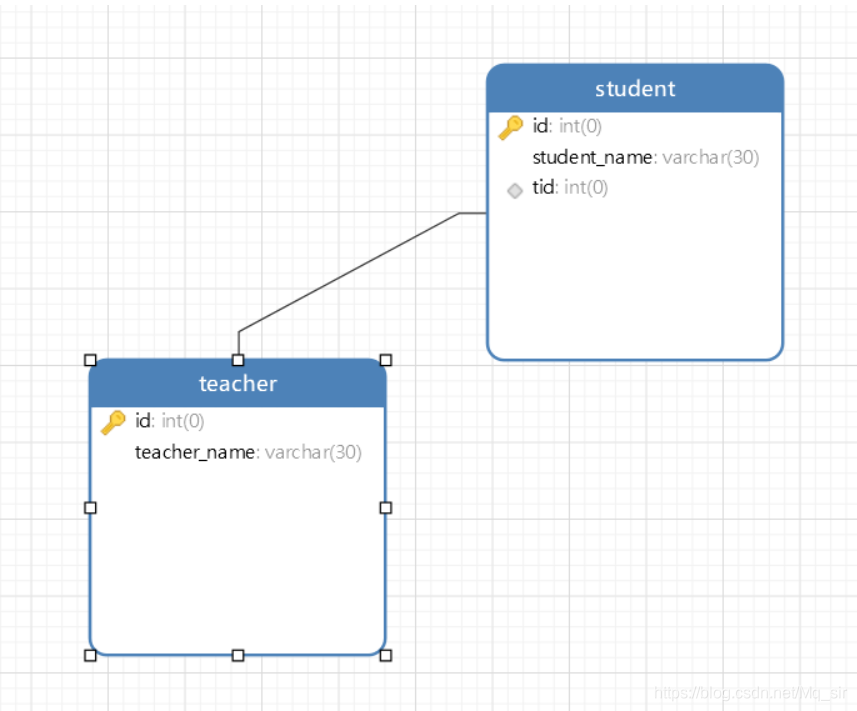吴凡 ベ莫离: 网友都说 MyBatis 多表查询太难了,小白:就这?我都学会了

MyBatis 实现多表查询
一、多对一查询
数据库的准备

创建两张表,一张老师表,一张学生表
将老师主键 id 关联学生外键 tid
创建 sql 的语句
create table teacher( id int primary key, teacher_name varchar(30) not null)
insert into teacher(id,teacher_name) values (1,'毛老师')
create table student( id int primary key, student_name varchar(30) not null, tid int default null)
//建立主外键关联alter table student add constraint teacher_student_id foreign key (tid) references teacher(id)
insert into student values (1,'小明',1)insert into student values (2,'小毛',1)insert into student values (3,'小红',1)insert into student values (4,'大黄',1)insert into student values (5,'超儿',1)
项目结构

使用 Lombok 插件,创建实体类。(提高整洁度,主要想 toulan)
@Datapublic class Student { private int id; private String name; //学生需要关联一个老师 private Teacher teacher;}
@Datapublic class Teacher { private int id; private String name;}
1、嵌套查询处理
1.编写接口
public interface StudentMapper { //查询所有学生的信息以及对应老师的信息 public List<Student> getStudent();}
2. 编写 StudentMapper.xml 的查询语句(重点)
<mapper namespace="dao.StudentMapper"><!-- 思路: 1. 查询所有学生的信息 根据查询出来的学生tid,寻找对应的老师
--> <select id="getStudent" resultMap="StudentTeacher"> select * from student </select> <resultMap id="StudentTeacher" type="pojo.Student"><!-- 复杂的属性需要单独处理 是对象就使用association,是集合就使用collection--><!-- select 子查询 --> <result property="name" column="student_name"/> <association property="teacher" column="tid" javaType="pojo.Teacher" select="getTeacher"/> </resultMap> <select id="getTeacher" resultType="pojo.Teacher"> select * from teacher where id=#{id} </select>
3.测试类
@Test public void getStudent(){
SqlSession sqlSession = Mybatisutil.getSqlSession(); StudentMapper mapper = sqlSession.getMapper(StudentMapper.class); List<Student> studentList = mapper.getStudent(); for (Student student : studentList) { System.out.println(student); } sqlSession.close(); }
测试结果

2、联合查询处理
1.编写接口
//按照结果嵌套查询public List<Student> getStudent2();
2. 编写 StudentMapper.xml 的查询语句(重点)
<!-- 按照结果嵌套处理--> <select id="getStudent2" resultMap="StudentTeacher2"> select s.id sid,s.student_name sname,t.teacher_name tname from student s,teacher t where s.tid=t.id </select> <resultMap id="StudentTeacher2" type="pojo.Student"> <result property="id" column="sid"/> <result property="name" column="sname"/> <association property="teacher" javaType="pojo.Teacher"> <result property="name" column="tname"/> </association> </resultMap>
3.编写测试类
@Test public void getStudent(){
SqlSession sqlSession = Mybatisutil.getSqlSession(); StudentMapper mapper = sqlSession.getMapper(StudentMapper.class); List<Student> studentList = mapper.getStudent2(); for (Student student : studentList) { System.out.println(student); } sqlSession.close(); }
测试结果

二、一对多查询
更改实体类
@Datapublic class Student { private int id; private String name; private int tid;}
@Datapublic class Teacher { private int id; private String name; //一个老师拥有多个学生 private List<Student> students;}
1、嵌套查询处理
1.编写接口
Teacher getTeacher2(@Param("tid") int id);
由于字段不一致,要做映射
2.主要 TeacherMapper.xml 的查询语句(重点)
<select id="getTeacher2" resultMap="TeacherStudent2"> select * from teacher where id=#{tid} </select> <resultMap id="TeacherStudent2" type="pojo.Teacher"> <result property="name" column="teacher_name"/> <collection property="students" javaType="ArrayList" ofType="pojo.Student" select="getStudentByTeacherId" column="id"/> </resultMap> <select id="getStudentByTeacherId" resultType="pojo.Student"> select * from student where tid=#{tid} </select>
3.测试类
@Test public void getTeacher(){
SqlSession sqlSession = Mybatisutil.getSqlSession(); TeacherMapper mapper = sqlSession.getMapper(TeacherMapper.class); Teacher teacher = mapper.getTeacher2(1); System.out.println(teacher); sqlSession.close(); }
测试结果:

Teacher(id=0, name=毛老师, students=[Student(id=1, name=null, tid=1), Student(id=2, name=null, tid=1), Student(id=3, name=null, tid=1), Student(id=4, name=null, tid=1), Student(id=5, name=null, tid=1)])
2、联合查询处理
1.编写接口
//获取指定老师下的所有学生及老师的信息 Teacher getTeacher(@Param("tid") int id);
由于字段不一致,要做映射
2.主要 TeacherMapper.xml 的查询语句(重点)
<!-- 按结果嵌套查询--> <select id="getTeacher" resultMap="TeacherStudent"> select s.id sid,s.student_name sname,t.teacher_name tname,t.id tid from student s,teacher t where s.tid=t.id and t.id=#{tid} </select> <resultMap id="TeacherStudent" type="pojo.Teacher"> <result property="id" column="tid"/> <result property="name" column="tname"/> <!-- 复杂的属性需要单独处理 是对象就使用association,是集合就使用collection javaType="" 指定的属性类型 集合中的泛型信息,使用ofType获取--> <collection property="students" ofType="pojo.Student"> <result property="id" column="sid"/> <result property="name" column="sname"/> <result property="tid" column="tid"/> </collection> </resultMap>
3.测试类
@Test public void getTeacher(){
SqlSession sqlSession = Mybatisutil.getSqlSession(); TeacherMapper mapper = sqlSession.getMapper(TeacherMapper.class); Teacher teacher = mapper.getTeacher(1); System.out.println(teacher); sqlSession.close(); }
测试结果:

Teacher(id=1, name=毛老师, students=[Student(id=1, name=小明, tid=1), Student(id=2, name=小毛, tid=1), Student(id=3, name=小红, tid=1), Student(id=4, name=大黄, tid=1), Student(id=5, name=超儿, tid=1)])
总结:
本章就使用了简单的两张表联合查询,介绍简单的使用,更复杂的多表联合主要在编写 sql 的时候难度大点,或者是嵌套查询要更严谨点官方文档也给了详细的非常复杂的多表查询如下: mybatis,这么复杂的看的我头疼
<!-- 非常复杂的语句 --><select id="selectBlogDetails" resultMap="detailedBlogResultMap"> select B.id as blog_id, B.title as blog_title, B.author_id as blog_author_id, A.id as author_id, A.username as author_username, A.password as author_password, A.email as author_email, A.bio as author_bio, A.favourite_section as author_favourite_section, P.id as post_id, P.blog_id as post_blog_id, P.author_id as post_author_id, P.created_on as post_created_on, P.section as post_section, P.subject as post_subject, P.draft as draft, P.body as post_body, C.id as comment_id, C.post_id as comment_post_id, C.name as comment_name, C.comment as comment_text, T.id as tag_id, T.name as tag_name from Blog B left outer join Author A on B.author_id = A.id left outer join Post P on B.id = P.blog_id left outer join Comment C on P.id = C.post_id left outer join Post_Tag PT on PT.post_id = P.id left outer join Tag T on PT.tag_id = T.id where B.id = #{id}</select>
在我们编写的时候注意点:
不要忘记注册 Mapper.xml
在初学的时候尽量不要给实体类取别名,为了不要混淆,加深理解
实体类字段要和数据库字段一致,如果不一致,那就要用 result 标签做映射
复杂的属性需要单独处理,是对象就使用 association,是集合就使用 collection 来映射
javaType="" 指定的属性类型
集合中的泛型信息,使用 ofType 获取
多注意复杂属性的嵌套使用
JavaType & ofType
JavaType 用来指定实体类中属性的类型
ofType 用来指定映射到 List 或者集合中的实体类 pojo 类型,泛型中的约束类型
以上就是《MyBatis 实现多表查询》的分享
也欢迎大家交流探讨,该文章若有不正确的地方,希望大家多多包涵。
你们的支持就是我最大的动力,如果对大家有帮忙给个赞哦~~~
牛哄哄的java大师
还未添加个人签名 2021.04.26 加入
还未添加个人简介












评论